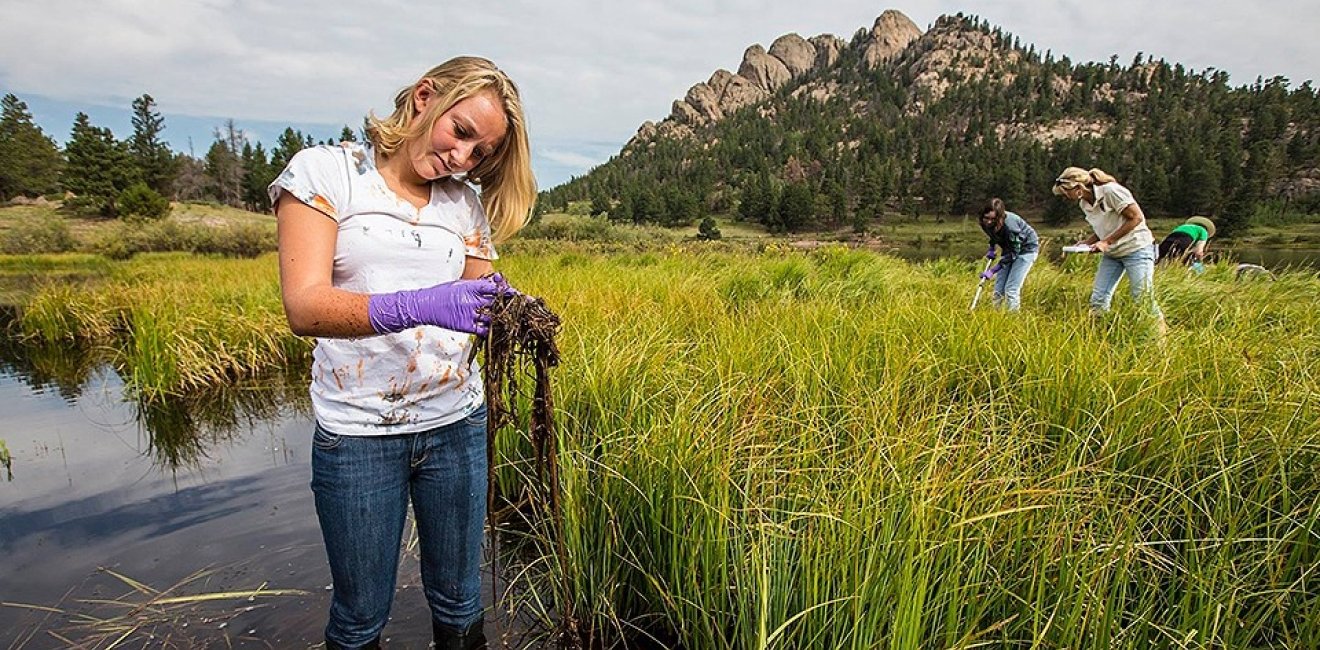
A blog of the Science and Technology Innovation Program

The National Environmental Monitoring Conference (NEMC) is the largest conference in North America focused on environmental measurements [1]. NEMC 2017, held August 7th to 11th in Washington, DC, featured a half day citizen science session moderated by Jay Benforado, USEPA Office of Research and Development, and Leon Vinci, Drexel University. The session began with five talks from citizen science researchers and practitioners, which inspired a larger discussion about the limitations and possibilities for expanding the impact and scope of citizen science for environmental monitoring. This blog post summarizes and reflects on this session.
Session co-chairs and speakers at NEMC. From left: Leon Vinci, Caren Cooper, Anne Bowser, Andrea Wiggins, Alison Parker, Shannon Dosemagen, and Jay Benforado. Photo Credit: Leon Vinci, used with permission.
Five Perspectives on Citizen Science for Environmental Monitoring
Building off an earlier keynote, Caren Cooper, Associate Professor of Forestry and Environmental Resources at North Carolina State University, kicked off the session by discussing the complementary strengths of citizen science “crowds” and “communities.” Cooper suggested that crowd-based citizen science can provide baseline data and reference information, while community-based citizen science can address a specific environmental concern. Coordination between both approaches is necessary for citizen science to reach its full potential.
Andrea Wiggins, a researcher joining the faculty of the University of Nebraska at Omaha, assessed how technologies currently support citizen science activities. Wiggins observed that in many cases technologies initially designed for purposes like community management are used (or “appropriated”) to serve other functions, like data management. Projects that appropriate technology should be aware that the values of a technology designer often become embedded in technology design, and consider how the initial values of a technology do or do not match a new context of use.
Anne Bowser, a Senior Program Associate at the Woodrow Wilson International Center for Scholars, discussed the motivations of citizen science volunteers. She looked across research projects to identify five motivations that consistently drive participation: (1) fun and enjoyment; (2) interest in a topic and learning more about it; (3) recognition and feedback; (4) individual relationships and community membership; and, (5) pursuit of shared goals such as science and conservation. Bowser also shared insights from two citizen science projects, CoCoRaHS and Adventure Scientists, that excel at recruiting and retaining volunteers.
Alison Parker, an ORISE Fellow hosted by the EPA, began by establishing the importance of community citizen science at EPA. Parker presented recommendations from the National Advisory Council for Environmental Policy (NACEPT) report, Environmental Protection Belongs to the Public: A Vision for Citizen Science at EPA [2]. This report outlines strategic recommendations for the agency to leverage citizen science to advance its mission, beginning with “embrace citizen science as a core tenet of environmental protection.”
Citizen scientists learn water sampling techniques on the Mississippi River. Photo Credit: Wisconsin Department of Natural Resources, CC BY-ND.
The final presentation by Shannon Dosemagen, Executive Director of Public Lab, explored how the Public Lab model helps communities use open-source tools to expand environmental exploration and investigation. Dosemagen encouraged the audience to consider an ethic of openness, sharing, and accessibility as written in the Gathering for Open Science Hardware (GOSH) manifesto [3]. She shared stories of her work supporting environmental monitoring related to one-time disasters such as the BP oil spill, as well as persistent systemic inequalities, like disproportionate levels of air pollution in fenceline communities around the globe.
These presentations led to an interesting discussion. Noting that some talks highlighted citizen science projects conducting research in domains like biodiversity, weather, and astronomy, Benforado wondered where the champions of citizen science for environmental monitoring could be found. Panelists and the audiences agreed that more documentation is needed to highlight effective approaches. Numerous research and practical challenges were also discussed.
As often happens, a few attendees questioned the quality of data produced by citizen science projects, and whether citizen science data are usable in research, litigation, and regulation. A similar question was raised regarding the potential bias of passionate participants. Panelists discussed numerous steps taken to support data quality in citizen science, suggesting that it is actually pretty hard to “fake” data in a compelling way. They also emphasized that citizen science is still a form of scientific research subject and adheres to the relevant tenants. Bias, for example, can be confirmed or countered by reproducing a study in whole or in part.
One member of the audience asked why people contribute to citizen science. Panelists noted that, in the case of local community science, participation is personal and volunteers are motivated to preserve their livelihood. Larger, top-down projects motivate volunteers by creating a valuable user experience.
Recognizing that government support for certain types of environmental research and monitoring is decreasing, another member of the audience asked whether citizen science could be used to augment scarce resources. The panel answered a tentative “yes,” but also noted that citizen science requires substantial investments in terms of both time (e.g., for volunteer management) and other resources to be successful [4]. The panel also suggested that the point of citizen science is not just to get more data, but to teach volunteers, empower communities, and democratize science and society.
Next Steps for Citizen Science and Environmental Monitoring
Citizen science for environmental monitoring has yet to reach its full potential. Those who wish to help advance activities, or bring together sister communities of practice such as “citizen science” and “environmental justice,” could focus their efforts in a number of areas.
1. Designing, building, and understanding low-cost tools and technologies for environmental research. Organizations like Public Lab support a collaborative network of people who design, build, and use low cost, open-source tools for environmental monitoring. The EPA hosts an air quality sensor toolkit [5]. SciStarter is beginning to compile a database of tools that volunteers can build, borrow, or buy [6]. Despite these efforts, citizen science still lacks a single point of access for information on the full range of available tools including the cost, usability, accessibility, and quality of the data produced by each. A comprehensive inventory of low-costs tools for environmental monitoring would help projects find technologies to appropriate or use directly, help funders recognize gaps in tool availability, and help organizations like Public Lab fill these gaps by designing and sharing more open source hardware.
2. Understanding the pathways and pipelines for getting data used in research, regulation, and policymaking. When asked about her favorite citizen science project, Doesmagan shared her appreciation of fenceline community members who persistently document local environmental conditions in formats ranging from journal logs of funky smells to newspaper clippings. Getting a wide range of data, especially qualitative data, used in research and regulation is a known challenge in environmental and environmental health research [7].
Some efforts are underway to address this issue. Researchers at the Environmental Law Institute have identified areas for influence by identifying laws, such as the Clean Water Act and Endangered Species Act, which explicitly invite citizen science into public decisions [8]. The Data and Metadata Working Group of the U.S. Citizen Science Association is devoted to developing PPSR CORE as a cross-disciplinary standard for collecting and documenting citizen science data [9]. But more work is needed to move beyond hypothetical opportunities and show concrete case studies where a range of citizen science activities have actually influenced decision-making. Case studies should include information such as the presence of baseline data (if any), the use of supporting tools and technologies, relevant domain-specific or regulatory standards, effective data collection and management practices, and the amount of time that elapsed between a project’s initiation and the desired outcome. Further, there should be support for citizen science projects who wish to improve their data collection, validation, documentation, and management practices but lack access to resources or expertise.
3. Documenting and publicizing a range of models and effective practices for conducting research with communities. Cooper and Parker made similar distinctions between large-scale citizen science, typically led by professional researchers, and smaller-scale, “community” citizen science where researchers and communities are partnered throughout the research process.
There is a wealth of knowledge in the citizen science community on motivation, especially regarding how to incentivize volunteers by, for example, helping them excel at their hobbies [10]. Community citizen science is different. Rather than advancing research, these projects are conducted to secure human “rights to basic amenities,” and are inherently local rather than national or global in scope. Members of the public are not motivated as much as engaged, through processes that often prioritize funding equity, management parity, and science for compliance [11].
While there are important research questions to be studied, advancing citizen science for environmental monitoring requires a range of capacity building activities. Support is needed for the network of people and organizations engaged in monitoring such as the Citizen Science Association (CSA) and related environmental justice communities. These organizations can develop, host, or link to case studies and resources like toolkits or databases that require community contributions and upkeep. Government agencies who support citizen science projects and use their data are also important stakeholders to engage, as are the people who conduct monitoring directly, to benefit human and environmental health.
Citizen scientists sampling in Rocky Mountain National Park. Ecological monitoring and biodiversity monitoring are highly relevant to environmental monitoring activities. Photo credit: NPS, public domain.
References
1. “National Environmental Monitoring Conference.” National Environmental Monitoring Conference. Accessed August 11, 2017. http://www.nemc.us/index.php
2. National Advisory Council for Environmental Policy and Technology. Environmental Protection Belongs to the Public: A Vision for Citizen Science at EPA. 2016. https://www.epa.gov/sites/production/files/2016-12/documents/nacept_cs_report_final_508_0.pdf
3. “GOSH Manifesto” Gathering for Open Science Hardware. Accessed August 11, 2017. http://openhardware.science/gosh-manifesto/
4. Wiggins, Andrea. “Free as in puppies: Compensating for ICT constraints in citizen science.” CSCW’13 Proceedings of the 2013 conference on Computer supported cooperative work (2013): 1469-1480. Accessed August 11, 2017. doi: 10.1145/2441776.2441942
5. “Air Sensor Toolbox for Citizen Scientists, Researchers and Developers.” EPA. Last modified July 26, 2017. https://www.epa.gov/air-sensor-toolbox
6. Prange, Erica. “Making Citizen Science Tools Accessible and Discoverable” Discover Magazine. December 4, 2016. Accessed August 11, 2017. http://blogs.discovermagazine.com/citizen-science-salon/2016/12/04/2944/#.WY3Ra3eGO_t
7. 2016 Environmental Health Summit. Community Engaged Research and Citizen Science: Advancing Environmental Public Health to Meet the Needs of Our Communities. Research Triangle Park, NC: Research Triangle Environmental Health Collaborative, 2016. http://environmentalhealthcollaborative.org/images/2016_Summit_Recommendations_FINAL.pdf
8. McElfish, J., Pendergrass J., Fox T. Clearing the Path: Citizen Science and Public Decision Making in the United States. Washington, DC: Woodrow Wilson International Center for Scholars, 2016. http://www.eli.org/sites/default/files/eli-pubs/clearing-path-eli-report.pdf
9. “Data Metadata Working Group.” Citizen Science Association. Accessed August 11, 2017. http://citizenscience.org/association/about/working-groups/data-and-metadata-working-group/
10. Sacoby M. Wilson. “An Ecologic Framework to study and Address Environmental Justice and Community Health Issues.” Environmental Justice 2 (2009): 15-24.
11. Brian Sullivan, et al. “The eBird enterprise: An integrated approach to development and application of citizen science.” Biological Conservation 169 (2013):31-40. Accessed August 11, 2017. doi 10.1016/j.biocon.2013.11.003
Author




